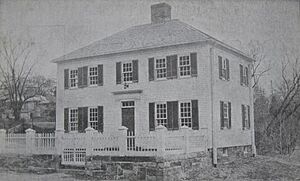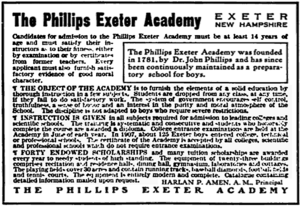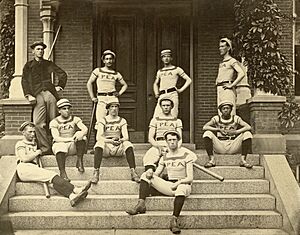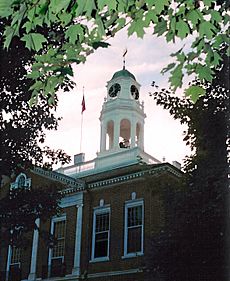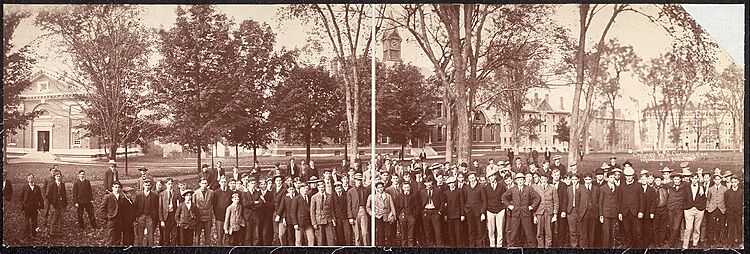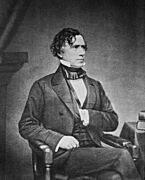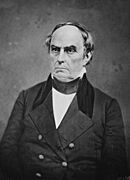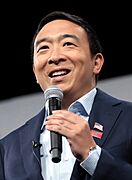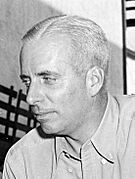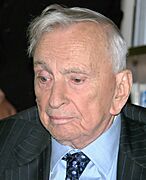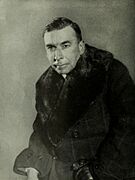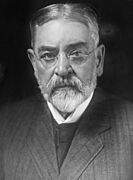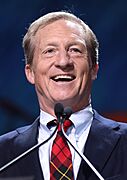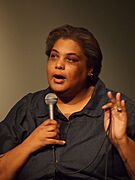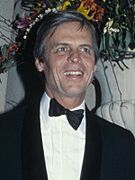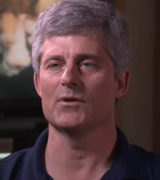Phillips Exeter Academy facts for kids
Quick facts for kids Phillips Exeter Academy |
|
|---|---|
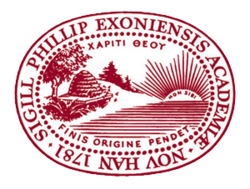
Official seal
|
|
| Location | |
|
20 Main Street
03833
|
|
| Information | |
| Type | |
| Motto | |
| Religious affiliation(s) | Nonsectarian |
| Established | 1781 |
| Founder |
|
| CEEB code | 300185 |
| Principal | William K. Rawson |
| Faculty | 217 |
| Grades | 9–12, PG |
| Gender | Coeducational |
| Enrollment |
|
| Average class size | 12 students |
| Student to teacher ratio | 6:1 |
| Campus size | 700 acres (280 ha) |
| Campus type | Suburban |
| Color(s) | Lively Maroon and Grey |
| Athletics |
|
| Athletics conference |
|
| Team name | Big Red |
| Rival | Phillips Academy (Andover) |
| Accreditation |
|
| Newspaper | The Exonian |
| Yearbook | PEAN |
| Endowment | $1.6 billion (June 30, 2024) |
| School fees | Books & Supplies: $900 |
| Tuition | Boarding: $69,537 Day: $54,312 |
| Affiliations |
|
| Alumni | Old Exonians |
Phillips Exeter Academy (also called Exeter or PEA) is a special kind of school in Exeter, New Hampshire. It is an independent school, meaning it is not run by the government. It is also co-educational, so both boys and girls attend. It is a college-preparatory school, which means it gets students ready for college.
Exeter was started in 1781, making it one of America's oldest boarding schools. About 1,100 students live at the school (boarding students) or come for the day. They are in grades 9 to 12, plus some students who take an extra year after high school.
Exeter is one of the richest boarding schools in the country. It has a large fund of money, called an endowment, which was $1.6 billion in June 2024. The school also has the world's largest high school library. Exeter accepts students based on their abilities, not on how much money their families have. This is called need-blind admission. The school even offers free tuition to students whose families earn less than $125,000 a year. Many famous people have gone to Exeter, including a U.S. president, a U.S. senator, the founder of Facebook, and three winners of the Nobel Prize.
Contents
School History
How Exeter Began
Phillips Exeter Academy was founded in 1781 by John and Elizabeth Phillips. They were important people in Exeter, New Hampshire. It is the sixth-oldest boarding school in the United States.
John Phillips went to Harvard College and became a teacher in Exeter in 1741. He became rich as a merchant and banker. He also became an important advisor and judge. In 1778, he helped his nephew, Samuel Phillips Jr., start Phillips Academy in Andover, Massachusetts. Because of this family connection, the two schools have a friendly and old rivalry. John Phillips wanted Exeter to be open to "youth of requisite qualifications from every quarter." This meant students from all backgrounds could attend if they were qualified.
Other people also helped the new school. John Phillips' first wife, Sarah Gilman, left him a lot of money, which helped him fund the school. The Gilman family also gave land for the school. The first students in 1783 included seven Gilmans. In 1814, Nicholas Gilman, who signed the U.S. Constitution, gave money for the school to teach sacred music.
The school's first building was the First Academy Building. It was built in 1783. Today, it is still close to its original spot. The building was officially opened on February 20, 1783. On that same day, William Woodbridge was chosen as the school's first leader, called the Preceptor.
John Phillips wrote the school's Deed of Gift when he founded it. This document explains that Exeter's goal is to teach students both goodness and knowledge. He wrote that teachers should care most about students' minds and morals. He believed that knowledge without goodness is dangerous. But goodness and knowledge together create the best people who can help others.
Exeter in the 1800s
In the early 1800s, there was a big religious difference between Harvard (Unitarian) and Yale (Calvinist). Because of this, Exeter became closer to Harvard, and Andover became closer to Yale. At first, most Exeter graduates did not go to college. But many who did went to Harvard. From 1846 to 1870, Exeter sent more students to Harvard than any other school. During this time, 16% of all Harvard students came from Exeter.
Exeter's first Black student was Moses Uriah Hall, who joined in 1858. He fought in the Civil War and later became a skilled stonemason. Six years later, five White students from Kentucky threatened to leave because another young Black man joined their class. The Principal, Gideon Lane Soule, reportedly told them, "You may do as you please — your classmate will stay."
In the 1880s, Exeter briefly changed its focus from college preparation to general education. Only 18% of students went to college then. But Charles Everett Fish (who led the school from 1890–95) brought back high academic standards. He would expel students who did not keep a C average. A student from 1892 remembered that good grades were the most important thing. The number of students going to college quickly went back up. However, the number of students at the school dropped from 355 in 1890 to 123 in 1895.
Harlan Page Amen (who led the school from 1895–1913) made Exeter's main goal to prepare students for college. He also improved the school's reputation, as students had been known for bad behavior. He doubled tuition from $75 to $150 between 1895 and 1899. He said in 1903 that he had expelled 400 boys in eight years. He also made living on campus better. By 1903, two-thirds of Exeter students lived at the school. Even with expulsions, many parents liked Exeter's new focus. Enrollment jumped to 390 in 1903 and 572 in 1913. From 1890 to 1894, 67% of Exeter's college-bound students went to Harvard, Yale, or Princeton.
From 1879 to 1881, Exeter hosted students from China. They were part of the Chinese Educational Mission. These students came to the U.S. to learn about Western technology. But they were called back after only two years. This was due to problems between the U.S. and China. Also, the Chinese government worried the students were becoming too American.
The Harkness Gift and School Growth
Lewis Perry became principal in 1914 and led the school until 1946. His early years were tough financially. The Academy Building burned down, and World War I caused problems. But he was good at getting money from rich people. He was a professional fundraiser and spent a lot of time telling people about Exeter and getting donations. The school's money fund grew nine times bigger during his time. By 1936, Exeter had an $8 million fund for about 700 students. This made it the richest boarding school in New England.
Perry used the money to make student life better. He also helped more students from different backgrounds attend. He made sure all students had housing for the first time. Perry also decided that at least 20% of students should receive scholarships. He added more rules for students' activities after class. This included stopping student groups called fraternities in 1940. These rules actually helped students behave better and improve their grades. From 1922 to 1931, the number of students asked to leave for academic reasons dropped from 136 to 40. When Perry retired, 725 boys attended the school.
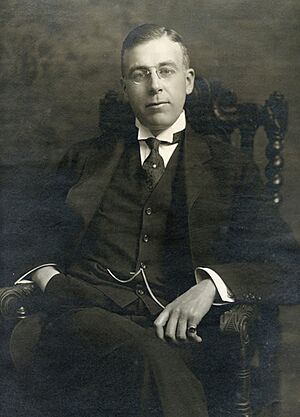
Perry's biggest gift came on April 9, 1930. A rich person named Edward Harkness wrote to Perry. He suggested a new way of teaching and offered to pay for it. He imagined a classroom where students and a teacher would sit around a table. They would talk and share ideas, like a discussion group. This idea was a big change in how schools taught.
This new way of teaching became "The Harkness Method." In this method, a teacher and a small group of students work together. They discuss ideas and information in a seminar style. In November 1930, Harkness gave Exeter $5.8 million (which would be about $110 million today) to support this. To teach in this new way, Exeter's teachers grew from 32 in 1914 to 82 in 1946. Also, because of Harkness's generosity, the school did not have to cut teacher salaries during the Great Depression. This was rare for boarding schools at the time.
Since 1930, Exeter's main way of teaching has been through discussion. Classes happen around an oval table called the Harkness Table. Today, all classes use this method, with no more than 12 students in each class.
More Recent History
William Saltonstall '24 (who led the school from 1946-63) followed Perry. He also did a great job raising money. He started by raising $5.6 million (about $72 million today) by 1948. Later that year, J. P. Morgan partner Thomas W. Lamont '88 left Exeter another $3.5 million in his will.
Under Saltonstall, Exeter kept strong connections with top universities. Exeter helped test the Advanced Placement (AP) program. In 1957, 11 of the 30 Harvard students who had enough AP credit to start as sophomores came from Exeter. Also, in 1963, Exeter had 73 National Merit Scholarship finalists, the most in the country. However, more students from public schools started applying to top universities. This meant Exeter students no longer got into their chosen colleges automatically. From 1953 to 1963, the percentage of Exeter graduates accepted to Harvard, Yale, or Princeton dropped from 67% to 42%.
Because fewer students were applying, the school decided to welcome a wider variety of students. In 1969, Exeter stopped requiring students to attend weekly religious services. In 1970, it became coeducational, meaning both boys and girls could attend. Later, in 1987, the school appointed its first female principal, Kendra Stearns O'Donnell. In 1996, a new Latin phrase was added to the Academy Building entrance. It says, Hic Quaerite Pueri Puellaeque Virtutem et Scientiam ("Here, boys and girls, seek goodness and knowledge"). This was to show that the school was now for both genders. This new phrase was added next to the original one, Huc Venite, Pueri, ut Viri Sitis ("Come hither boys so that ye may become men"). By 1999, 55% of new Exeter students came from public schools.
On January 25, 2019, William K. Rawson '71 became the 16th Principal Instructor. He is the fourth Exeter graduate to be Principal. In 2021, Rawson announced that Exeter would use a need-blind admissions policy. This means the school accepts students without looking at their family's ability to pay. This was possible after a $90 million fundraising effort for financial aid.
College Admissions
In the late 1900s, colleges started looking at more than just grades for admissions. They also considered other factors, like a student's background. Exeter reports that from 2022-2024, many students went to Ivy League colleges and MIT. But also, 10 or more students went to other great schools like Boston College, Bowdoin, Georgetown, NYU, Tufts, and the University of Chicago.
Academics at Exeter
Classes and Grades
Exeter uses an 11-point grading system. An A is worth 11 points, and an E is worth 0 points. There are 6 students for every teacher. Also, 93% of Exeter teachers have advanced degrees beyond college.
Students who attend Exeter for four years must take classes in arts, languages (classical or modern), computer science, English, health, history, math, religion, and science. Most students get an English diploma. But students who take many Latin and Ancient Greek classes receive a Classical diploma.
Exeter helped create the Advanced Placement (AP) program. However, Exeter no longer offers AP courses. The school believes its courses are often harder than AP classes and are taught at a college level. Exeter was one of the first private schools to stop offering AP classes, starting in the early 2000s.
Harkness Teaching Method
All classes at Exeter are taught using the Harkness Method. Students sit around oval Harkness Tables, and there are no more than 10-12 students per class. Classrooms do not have rows of desks, and teachers rarely give long lectures. When the Phelps Science Center was built in 2001, all science classes could also be taught around Harkness Tables. Parts of the Harkness Method, including the Harkness Table, are now used in many independent schools worldwide.
Test Scores
The average combined SAT score for the Class of 2024 was 1440. This included 717 for reading and 723 for math. Even though Exeter does not offer AP courses, students can still take AP exams if they want. For the Class of 2023, 94% of students passed their AP exams.
Off-Campus Study
Exeter offers programs where students can study away from campus. The Washington Intern Program lets students work in a senator's or representative's office. Exeter also takes part in the Milton Academy Mountain School program. This allows students to study in a small, rural setting in Vermont. The school also has foreign study programs in places like Grenoble, Tokyo, and Stratford-upon-Avon. There are also school-year abroad programs in Beijing, Rennes, and Zaragoza. Plus, foreign language summer programs are offered in France, Japan, Spain, and Taiwan.
Student Life
Student Body
Exeter accepts about 14–18% of students who apply each year. In 2024, 18% of applicants were accepted. In 2024, 78.5% of accepted students chose to enroll at Exeter.
Exeter has accepted students based on need-blind admission since 2021. This means a student's family income does not affect their chances of getting in. In the 2023–2024 school year, 13% of students had a family member who also attended Exeter.
In the 2024–2025 school year, Exeter had 225 freshmen (called "juniors" or "preps"). There were 252 sophomores ("lower middlers" or "lowers"), 304 juniors ("upper middlers" or "uppers"), and 325 seniors and postgraduates. This made a total of 1,106 students.
Diversity at Exeter
Exeter has students from many different races and backgrounds. In the 2024–2025 school year, 57.1% of Exeter students were students of color. In the 2019–2020 school year, 52% of the 314 new students had previously attended U.S. public schools.
In September 2024, Exeter had students from 44 states, the District of Columbia, Guam, and 32 other countries. About 9.9% of students are international students. Another 6.2% are U.S. citizens living outside the United States.
Most Exeter students (81%) live on campus in dorms. The other 19% are day students who travel to school from nearby towns.
Money Matters
Tuition and Financial Aid
For the 2024–2025 school year, Exeter charged boarding students $69,537. Day students paid $54,312. About 45% of Exeter students receive financial aid. On average, this aid covers $56,315 for boarding students and $37,770 for day students.
Exeter accepts students on a need-blind basis. This means they promise to cover 100% of a family's proven financial need. Since 2008, Exeter has also guaranteed free tuition for families with incomes below a certain amount. In 2024, this amount was raised from $75,000 to $125,000.
Endowment and Spending
Exeter's financial fund, or endowment, was $1.6 billion as of June 30, 2024. In its reports for the 2021-22 school year, Exeter had total assets of $1.91 billion. It also reported $124.0 million in program expenses and $25.3 million in grants, mostly for student financial aid.
Campus Buildings
Academic Buildings
- The Academy Building (1914) is the fourth building of its kind. It was built after the third one burned down. It holds the History, Math, Religion, and Classical Languages departments. It also has an archaeology/anthropology museum. In the 1920s and 1930s, Lewis Perry added the Assembly Hall and connected it to the Mayer Art Center.
- The Mayer Art Center (1903) is home to the Art Department and the Lamont Gallery. It also has the College Counseling Office. It has a large ceramics studio, printmaking studios, drawing/painting studios, and a 3-D design studio. The school bought a 3-D printer in 2013.
- The Class of 1945 Library (1972) is the biggest high school library in the world. It can hold 250,000 books. In 2007, people voted its design as #80 on the list of America's Favorite Architecture. A famous architecture critic called it a "stunning tribute to books."
- The Elizabeth Phillips Academy Center (EPAC) (2006) is the school's student center. It has a student common area, a post office, a lounge for day students, an academic support center, a student grill, and an auditorium called the Forum. It also hosts many student clubs.
- The Goel Center (2018) houses the theater and dance departments.
- Phillips Hall (1932) is where the English and Modern Languages departments are located. It was built specifically for the new Harkness system.
- The Phelps Science Center (2001) has science labs and classrooms. In 2004, the architects who designed it won an award for their work.
- The Forrestal Bowld Music Center (1995) is home to the Music Department. It has a music library, a recital hall, rehearsal halls, and many practice rooms. It also won an award for its design in 1996.
Sports Facilities
- The George H. Love 1917 Gymnasium (1969) has 10 squash courts, a swimming pool, three basketball courts, a weight room, a sports-science lab, and two hockey rinks.
- The William Boyce Thompson 1890 Gymnasium (1918) has a basketball court, a dance studio, a cycling training room, a second swimming pool, and a media room.
- The Thompson Fieldhouse (2018) has four indoor tennis courts, two batting cages, a wrestling room, and an indoor track.
- The Downer Family Fitness Center (2015) has weight lifting equipment, exercise machines, and turf space.
- The Roger Nekton Championship Pool is named after a long-time swimming and water polo coach.
- The William G. Saltonstall Boathouse (1990) is a rowing facility on the Squamscott River.
- Outdoor sports areas include:
- Phelps Stadium for football, soccer, lacrosse and field hockey
- Amos Alonzo Stagg 1884 Baseball Diamond
- Hilliard Lacrosse Field
- George Arthur Plimpton 1873 Playing Fields
- Ralph Lovshin Track, named for the school's long-serving track coach.
The school also has 19 outdoor tennis courts, miles of cross-country trails, and a wrestling practice room.
Other Buildings
- Phillips Church was first built as a church in 1897 and bought by the school in 1922. It was designed by Ralph Adams Cram. Even though it was a church, it now has spaces for students of many faiths. It includes a Hindu shrine, a Muslim prayer room, a kosher kitchen, and a meditation room.
- Nathaniel Gilman House (1740) is where the school's Alumni and Alumnae Affairs and Development Office is located. This house and the Benjamin Clark Gilman House were built for the Gilman family, who were important donors to Exeter.
- The Davis Center, which used to be a library, now holds the financial aid offices. It was designed by Ralph Adams Cram.
Sports
Exeter offers 65 interscholastic sports teams at different levels. It also has 27 intramural sports teams and various fitness classes. All students must take part in sports.
Many Exeter teams have won recent championships in New England. These include basketball, water polo, wrestling, swimming, cycling, soccer, squash, cross country, crew, and ice hockey.
Exeter has had many great athletes graduate in recent years. For example, Olympians in crew include Anne Marden '76 and Andréanne Morin '02. Georgia Gould won an Olympic medal in mountain biking. Duncan Robinson plays for the Miami Heat in the National Basketball Association. Sam Fuld played 8 years of Major League Baseball.
Exeter's main sports rival is Phillips Academy, also known as Andover. The two schools have played against each other in baseball and football since 1878. Today, the Exeter-Andover weekend is still a big tradition at both schools.
Exeter also competes against other private schools in New England. These include Belmont Hill School, Deerfield Academy, Choate Rosemary Hall, and Milton Academy.
Student Life and Clubs
The school has over 100 clubs listed. The number of active clubs changes. The Exonian is the school's weekly newspaper. It is the oldest continuously published high school newspaper in the U.S., started in 1878. The Exonian has won awards for its quality. Other old clubs include ESSO, which helps with community service, and the PEAN, which is the school's yearbook. Exeter also has the oldest surviving high school society, the Golden Branch (founded in 1818). This group was for public speaking and is now called the Daniel Webster Debate Society. Exeter's Model UN club has won awards. Its Mock Trial Association has won many state titles and placed in the top ten nationally.
Almost 80% of students live in the dorms. The other 20% travel from homes within 30 miles. Each dorm has teachers and older student leaders called proctors. There are check-in times in the evenings for students.
Religious life on campus is supported by the Religious Services Department. They have a stone chapel and offer services for students' spiritual needs. The chapel was built in 1895 and has been updated. It has spaces for worship and meditation for students of many faiths. This includes Christian, Muslim, Jewish, Hindu, Quaker, and Buddhist traditions.
Students used to have to attend a religious service each week until 1969. After that, religion at Exeter changed. A renovation of Phillips Church in 2002 created spaces for worship and meditation for students from different religious backgrounds.
School Symbols
Academy Seal
Exeter has two main symbols: a seal and the Lion Rampant. The seal shows a river, sun, and a beehive. It also includes the school's mottos. The seal is similar to the one used by Phillips Academy. A beehive often represents hard work and teamwork. The Lion Rampant comes from the Phillips family's coat of arms. It suggests that all graduates are part of the "Exonian family."
Exeter has three mottos on its seal:
- Non Sibi (Latin for 'Not for oneself'). This means living a life focused on community and duty.
- Finis origine pendet (Latin for 'The end depends on the beginning'). This shows Exeter's focus on hard work to prepare for a good adult life.
- Χάριτι Θεοῦ (Greek for 'By the grace of God'). This reflects the school's religious beginnings. Today, the only part of this is that most students must take two courses in religion or philosophy.
School Colors and the Alumnus Tie
Phillips Exeter Academy has several school colors, including crimson red and white, or burgundy red and silver. Black is also used a little. The official school colors are lively maroon and gray. The traditional school tie is burgundy red with diagonal silver stripes and silver lions. The school's sports teams use the color PMS201.
Famous Graduates

Many famous people have graduated from Exeter. These include:
- US Senator Daniel Webster (1796)
- US President Franklin Pierce (1820)
- Abraham Lincoln's son, Robert Todd Lincoln (1860), who became the 35th Secretary of War
- "Grandfather of football" Amos Alonzo Stagg (1880)
- Pulitzer Prize-winning author Booth Tarkington (1889)
- John Knowles, author of A Separate Peace, who graduated in 1945. His novels are set at a fictional school similar to Exeter.
Other notable graduates include:
- Politicians like Gifford Pinchot and Jay Rockefeller.
- Military leaders like Secretary of Navy George Bancroft.
- Authors like George Plimpton, Gore Vidal, John Irving, and Dan Brown.
- Business leaders like Mark Zuckerberg (Facebook founder) and Andrew Yang (entrepreneur and presidential candidate).
- Actors like Alessandro Nivola.
- Musicians like China Forbes and Win Butler.
- Educators like Claudine Gay.
- Athletes like Sam Fuld (baseball player).
Other Programs
Summer School
Each summer, Phillips Exeter hosts over 780 students from many different schools. They come for a five-week program of academic study. The summer program has students from over 40 different states and 45 foreign countries.
Exeter's summer school has two programs:
- Upper School: This offers many classes to high school students entering grades 10-12, and postgraduate students.
- Access Exeter: This program is for students entering grades 8 and 9. It offers advanced study in arts, sciences, and writing. It also helps students learn about the school. The Access Exeter program has six groups of courses. Each group has three classes based on a main theme. Some summer programs also let students study outside of Exeter's campus. This includes working with other top schools, visiting Washington D.C., and traveling abroad.
Workshops
The school offers many workshops and conferences for high school teachers. These include the Exeter Math Institute and the Exeter Humanities Institute. There are also conferences for Math, Science, and Technology, and Astronomy, and Shakespeare.
The "On Beyond Exeter" program offers one-week seminars for alumni. Most courses are held at the school. But some meet in places related to the course topic.
Historical Projects
In 1952, Exeter, Andover, Lawrenceville, Harvard, Princeton, and Yale published a study. It was called General Education in School and College: A Committee Report. This report suggested tests that would place students after they were accepted to college. This idea grew into the Advanced Placement Program.
In 1965, Exeter became the second school (after Andover) to join the School Year Abroad program. This program allows students to live and study a foreign language in another country.
See also
 In Spanish: Phillips Exeter Academy para niños
In Spanish: Phillips Exeter Academy para niños


